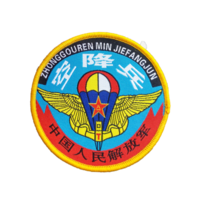| People's Liberation Army Air Force Airborne Corps | |
|---|---|
| 中国人民解放军空降兵军 Zhōngguó Rénmín Jiěfàngjūn Kōngjiàngbīng Jūn | |
 | |
| Active | 1961–present |
| Country | |
| Allegiance | |
| Branch | People's Liberation Army Air Force |
| Type | Air force ground forces and special forces |
| Role | Air assault Airlift Anti-aircraft warfare Anti-tank warfare Armoured warfare Bomb disposal CBRN defense Clandestine operation Close-quarters battle Cold-weather warfare Combat search and rescue Counterterrorism Desert warfare Direct action Direct fire Executive protection Fire support Force protection Forward air control Hostage rescue HUMINT Indirect fire Irregular warfare ISTAR JTAC Jungle warfare Long-range penetration Maneuver warfare Medical evacuation Military engineering Military logistics Mountain warfare Raiding Reconnaissance Special operations Tactical emergency medical services Tracking Urban warfare |
| Size | 40,000 personnel |
| Garrison/HQ | Xiaogan, Hubei |
| Engagements | Chinese Civil War Korean War Sino-Vietnamese conflicts (1979–1991) |
The People's Liberation Army Air Force Airborne Corps (simplified Chinese: 中国人民解放军空降兵军; traditional Chinese: 中國人民解放軍空降兵軍; pinyin: Zhōngguó Rénmín Jiěfàngjūn Kōngjiàngbīng Jūn; lit. 'Chinese People's Liberation Army Airborne Corps[2]') is a combined air force ground forces corps which consists of air assault infantry, airborne forces, and special forces under direct command of the People's Liberation Army Air Force (PLAAF). It was reorganized and renamed from the 15th Airborne Corps in May 2017[3] and now comprises six airborne brigades and a special forces brigade. The PLAAF Airborne Corps is China's primary strategic airborne unit and part of the newly formed rapid reaction units (RRUs)[citation needed] of the Chinese military which is primarily designated for air assault, airborne, long-range penetration, and special warfare missions. Its role is similar to that of the U.S. Army's XVIII Airborne Corps (the 82nd Airborne Division and 101st Airborne Division (Air Assault)), the British Army's Parachute Regiment, and the Russian Airborne Forces (VDV).
Only one of the PLAAF Airborne Corps' former three divisions (or just 2 to 3 of the current 7 brigades that form the corps) can deploy to any part of China within 48 hours due to limited airlift capabilities. In the late 1990s the airlift capability of the PLAAF consisted of 10 IL-76 heavy lift, Shaanxi Y-8, and Xi'an Y-7 transports, as well as Mi-17, Mi-8, Z-8, and Z-9 helicopters. As such, the PLAAF could only lift one division or two to three brigades of 11,000 men complemented with light tanks, mortars, and self-propelled artillery. In 1988, there were reports claiming that a 10,000 man airborne division was transported to Tibet in less than 48 hours.
- ^ "The PLA Oath" (PDF). February 2009. Archived (PDF) from the original on December 15, 2014. Retrieved October 30, 2015.
I am a member of the People's Liberation Army. I promise that I will follow the leadership of the Communist Party of China...
- ^ Chan, Joe. "FACTBOX - China's growing military clout". Reuters.
An instructor aligns the formation of the Chinese People's Liberation Army Airborne Corps during a training session at the 60th National Day Parade Village on the outskirts of Beijing, September 15, 2009.
- ^ "In-depth: A close look at Chinese airborne troops". english.chinamil.com.cn ("The Only Official English-Language News Website of the Chinese People's Liberation Army"). PLA Daily. August 29, 2017.
In early May this year, the 15th airborne corps was reorganized into the "corps of PLA airborne troops".